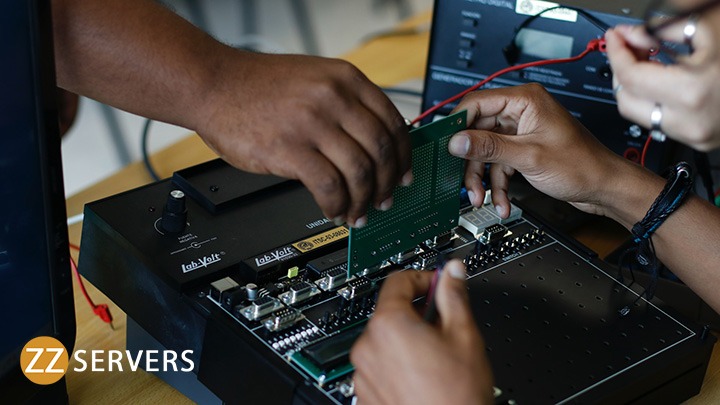IT maintenance services are essential tasks that keep computers and networks running smoothly. As businesses increasingly rely on technology for day-to-day tasks like document processing, accounting, presentations, and communication, their IT systems must perform at peak efficiency. However, over time, software and hardware can slow down due to reasons like dust build-up, virus attacks, or outdated parts.
It affects employee productivity and overall operations. Some key aspects of IT maintenance include preventive maintenance like system scans, updates, and patches to fix issues before they arise. Reactive maintenance helps resolve problems when they occur. Proactive maintenance keeps technology up-to-date for high performance. In this article, we will dive deep into the various types of IT maintenance tasks, their benefits, and why outsourcing these services ensures your business technology remains reliable.
What does IT Maintenance Involve?
While computers and networks make business operations seamless, keeping this technology running requires some effort. Regular maintenance is key to maximizing the performance of your IT assets. But with tasks ranging from software updates to security scans, it can take time to know where to begin. Let’s break down the different types of activities involved.
Preventive Maintenance
This proactive approach aims to identify issues before they impact your systems. It involves running diagnostics using the latest tools to spot vulnerabilities, outdated parts, or inefficient settings. For example, system scans check for malware infections while monitoring alerts flag potential hardware failures. Similarly, installing the latest patches and antivirus definitions plugs security gaps. Automated updates keep software optimized. By addressing small glitches early, preventive maintenance helps avoid costly repairs down the line.
Hardware Checks
IT professionals inspect devices physically for signs of wear and tear. They analyze components like processors, memory, cables, and ports to ensure they are functioning as intended. Thermal scans detect overheating risks while equipment inventory verifies assets. These checks ensure your PCs, servers, and other equipment run smoothly for years to come.
Software Maintenance

It includes verifying that applications and services are configured as per your business needs. Experts optimize settings, troubleshoot incompatibilities, and test for crashes/bugs. They also upgrade legacy software to maintain security and features. For instance, migrating to cloud-based versions makes systems more flexible.
Corrective Maintenance
No matter how robust your preventive plan is, unexpected issues may occur. That’s where corrective maintenance comes in. Technicians use systematic diagnostics to pinpoint and resolve the root cause of unplanned downtime. Whether it’s restoring data from backups after a ransomware attack or replacing a damaged hard drive, the goal is to minimize disruption to daily operations.
Security Measures
With cyber threats on the rise, security maintenance is paramount. Professionals conduct vulnerability assessments, install firewalls/antivirus, enforce access controls, and monitor networks for suspicious activity. Proper security protocols create an important line of defense for your sensitive data and brand reputation.
Preventive Maintenance: The First Line of Defense
As the adage goes, “prevention is better than cure.” And when it comes to your business’ technology systems, a proactive maintenance strategy can save you from significant headaches down the line. Regular preventive care helps identify small issues before they escalate, keeping IT resources running so you can focus on core operations.
System Monitoring & Diagnostics
IT experts closely track your network infrastructure and devices for early warning signs. Through monitoring tools, they can spot CPU or memory abnormalities, failing hardware components, insufficient storage space, and other “red flags.” It allows addressing glitches promptly before they majorly disrupt productivity. Diagnostic testing ensures all software and services are performing as intended.
Security Patches & Updates
Hackers are constantly finding new vulnerabilities to exploit. By installing monthly security patches, you plug security holes that threat actors may use to infiltrate networks—similarly, updating antivirus definitions guards against the latest malware variants. Automated update management makes it hassle-free.
Backup Verification
No matter how robust your backup solution is, verifying restoration capabilities is prudent. Technicians periodically test recovering data from archives to confirm files can be retrieved in a crisis. They also validate encryption for sensitive backups. This backup validation offers critical peace of mind.
Documentation & Planning
Technicians document all system configurations, software versions, maintenance tasks performed, support contracts, and more. This information proves invaluable when diagnosing complex issues or planning future upgrades. Change management procedures also help minimize disruptions.
When Issues Arise: Reactive Maintenance to the Rescue
Even with diligent preventive maintenance, unexpected issues will occur on occasion. It is where reactive maintenance comes in, allowing professionals to contain incidents before they escalate. While disruptions are frustrating, a swift response helps you resume productivity ASAP.

● Expert Diagnostics: When a system failure or software glitch arises, technicians leverage specialized tools and experience to diagnose the root cause accurately. Their in-depth analysis identifies whether it’s a hardware malfunction, software bug, malware infection, or user error requiring training.
● Targeted Repairs: With the problem diagnosed, experts address it through focused repairs. It may involve replacing faulty components, uninstalling/reinstalling applications, patching security vulnerabilities, or restoring data from backups. Their goal is a permanent fix to prevent reoccurrences.
● Remote Assistance: Leveraging remote access technology, technicians can often resolve issues without on-site visits through screen sharing. It speeds up support while maintaining social distancing. For sensitive matters, they don protective equipment to handle emergencies in person safely.
● Workarounds & Recovery: Should repairs take time, technicians provide interim workarounds to reduce downtime impact, like accessing data on alternate PCs. Comprehensive recovery procedures ensure the smooth restoration of full functionality.
● Documentation & Analysis: Each incident is thoroughly documented and analyzed to help refine preventive measures. Recurring problems may require equipment upgrades or configuration changes to strengthen resilience against future disruptions.
Keeping your IT Running Smoothly
While preventive and corrective maintenance help address immediate issues, proactive maintenance serves the important role of keeping your technology optimized for high productivity over the long run. Left unchecked, even a smoothly running system will experience gradual slowdowns that hamper operations.
● Scheduled Upgrades: Technicians install major software/firmware upgrades when available. These new releases boost features, security, and efficiency. For example, migrating from Windows 7 to 10 brings substantial speed and compatibility improvements. Hardware refreshes prevent obsolete devices from limiting functionality.
● System Tune-Ups: Experts perform regular wellness checks using diagnostic tools. They clean accumulated junk files and defragment disks, adjust virtual memory settings, and uninstall unused programs to restore quick responsiveness. Processes are optimized, and bottlenecks are removed.
● Capacity Planning: As data and user needs grow over time, storage, memory, and network bandwidth requirements change. Technicians help forecast upgrades needed to maintain performance standards as your organization scales.
● Documentation & Audits: Changes to systems and software are logged to retain configuration integrity. Periodic security audits ensure compliance with your policies and best practices. Vulnerability scans catch weaknesses before threats emerge.
Outsourcing IT Support- A Smart Choice for Businesses
While some businesses take on IT maintenance internally, outsourcing to a managed service provider has compelling advantages. Expert teams stay abreast of evolving best practices and can often complete tasks more efficiently at lower costs than hiring full-time staff.
● Dedicated Resources: An MSP’s sole focus is delivering flawless technology support. Their engineers work exclusively on maintenance, freeing your employees from disruptions and distractions associated with handling glitches in addition to core responsibilities.
● Ongoing Support: Most MSPs offer 24/7 monitoring and assistance. Problems can be addressed immediately before causing downtime. Remote management also enables quick fixes without staff being on-site.
● Cost Savings: By subscribing to fixed monthly plans, you gain predictability and avoid expensive break/fix bills. MSPs are also faster and more cost-effective for major projects like upgrades or new deployments.
● Scalability: As your business grows or needs change, an MSP scales its services up or down through flexible agreements. There’s no need to hire more in-house staff.
● Security Expertise: MSPs stay up to date on the latest threats and compliance regulations through intensive training programs. They secure your data with enterprise-grade tools and processes developed over years of hands-on experience.
● Peace of Mind: Rather than worrying about keeping technology running, you can rest assured reliable support is only a phone call away. MSPs are also accountable for meeting rigorous SLAs.
Rely on Experts for Reliable IT Maintenance
To keep your business technology running dependably without added headaches, consider partnering with ZZ Servers – an industry-leading IT support provider with over 17 years of experience. Our customized managed services plans deliver proven preventive maintenance, rapid incident response, and proactive optimizations to maximize productivity for organizations with 10-200 employees. The ZZ Servers team takes a personalized, process-driven approach focused on results, trust, and accountability. Contact us today at 800-796-3574 to discuss a maintenance solution tailored to your unique technology needs and budget. Our expert guidance will safeguard your systems and free your team to focus on core missions.
Frequently Asked Questions
u003cstrongu003eWhat are the signs that suggest my computer needs maintenance?u003c/strongu003e
Some signs include the system running slow, frequent error messages, programs crashing, poor performance, or weak security scans. Your network team can diagnose precisely using tools and recommend optimization.
u003cstrongu003eHow often should I get preventive maintenance done?u003c/strongu003e
Most experts suggest comprehensive checks every quarter, along with monthly updates and monitoring. This steady approach catches small issues before major disruptions. As needs evolve, an MSP can customize the frequency.
u003cstrongu003eWhat are some common computer problems that maintenance can fix?u003c/strongu003e
Common fixable issues involve malware/virus removal, configuration errors, missing patches, hardware failures, network glitches, and user training needs. Preventive maintenance addresses these before they spiral.
u003cstrongu003eWhat are the benefits of outsourcing IT support vs. an in-house team?u003c/strongu003e
Outsourcing to an MSP provides on-demand access to extensive skills and resources and scales easily with growth. It ensures issues are handled promptly by professionals who are able to handle business budgets and resources.
u003cstrongu003eWhat does a typical maintenance contract cover?u003c/strongu003e
Comprehensive support agreements usually include security maintenance, helpdesk, backups, hardware/software support, upgrades, and priority response. Coverage can vary but aims to optimize systems and keep operations running uninterrupted.


